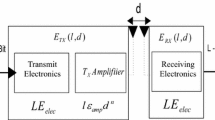Abstract
Wireless sensor networks will be responsible for the majority of the growth in smart building systems over the next decade. In resource constrained wireless sensor networks, it is very important to design the protocols with energy efficiency to prolong the lifetime of the sensor networks. Node clustering and data aggregation become popular since cluster-based sensor network can enhance the whole network throughput by aggregating the collected sensory information in each cluster. In such a network, the cluster head nodes play an important role in forwarding data originated from other common nodes to the sink. As a consequence, the cluster head nodes will have the problem of quick energy depletion upon multiple packets forwarding in high data load sensor networks. In this paper, we proposed a simple cluster-based linear network coding protocol in which random linear network coding is applied at cluster head nodes in order to minimize the number of forward packets to the sink. Simulation results are provided to show the efficacy of the proposed method in terms of the throughput and end-to-end delay.
Access this chapter
Tax calculation will be finalised at checkout
Purchases are for personal use only
Similar content being viewed by others
References
Karl, H., Willig, A.: Telecommunication Networks Group: A Short Survey of Wireless Sensor Networks, October 2003
Kuorilehto, M., Hannikainen, M., Hamalainen, T.D.: A survey of application distribution in wireless sensor networks. EURASIP Trans. Wirel. Commun. Netw. 5(5), 774–788 (2005)
Haenggi, M.: Opportunities and challenges in wireless sensor networks. In: Handbook of Sensor Networks: Compact Wireless and Wired Sensing Systems, pp. 1.1–1.14. CRC Press, Florida (2004)
Akyildiz, F., et al.: Wireless sensor networks: a survey. Comput. Netw. 38, 393–422 (2002)
Shan-Shan, L., Pei-Dong, Z., Xiang-Ke, L., Wei-Fang, C., Shao-Liang, P.: Energy efficient multipath routing using network coding in wireless sensor networks. In: Kunz, T., Ravi, S.S. (eds.) ADHOC-NOW 2006. LNCS, vol. 4104, pp. 114–127. Springer, Heidelberg (2006)
Ahlswede, R., Cai, N., Li, S.Y.R., Yeung, R.W.: Network information flow. IEEE Trans. Inf. Theor. 46, 1204–1216 (2000)
Fragouli, C., Wismwer, J., Le Boudec, J.Y.: A network coding approach to energy efficient broadcasting: from theory to practice. In: Proceedings of ACM MobiSys 2006 (2006)
Katti, S., Rahul, H., Hu, W., Katabi, D., Medard, M., Crowcroft, J.: Xors in the air: practical wireless network coding. In: Proceedings of ACM SIGCOMM 2006, September 2006
Perkins, C.E., Royer, E.M.: Ad-hoc on-demand distance vector routing. In: Proceedings of the Second IEEE Workshop on Mobile Computing Systems and Applications, pp. 90–100, February 1999
Acknowledgement
This research is funded by the Republic of Singapore’s National Research Foundation through a grant to the Berkeley Education Alliance for Research in Singapore (BEARS) for the Singapore-Berkeley Building Efficiency and Sustainability in the Tropics (SinBerBEST) Program. BEARS has been established by the University of California, Berkeley as a center for intellectual excellence in research and education in Singapore.
Author information
Authors and Affiliations
Corresponding author
Editor information
Editors and Affiliations
Rights and permissions
Copyright information
© 2015 Institute for Computer Sciences, Social Informatics and Telecommunications Engineering
About this paper
Cite this paper
Shwe, H.Y., Chong, P.H.J. (2015). Building Efficient Multi-level Wireless Sensor Networks with Clustering. In: Mumtaz, S., Rodriguez, J., Katz, M., Wang, C., Nascimento, A. (eds) Wireless Internet. WICON 2014. Lecture Notes of the Institute for Computer Sciences, Social Informatics and Telecommunications Engineering, vol 146. Springer, Cham. https://doi.org/10.1007/978-3-319-18802-7_2
Download citation
DOI: https://doi.org/10.1007/978-3-319-18802-7_2
Published:
Publisher Name: Springer, Cham
Print ISBN: 978-3-319-18801-0
Online ISBN: 978-3-319-18802-7
eBook Packages: Computer ScienceComputer Science (R0)




